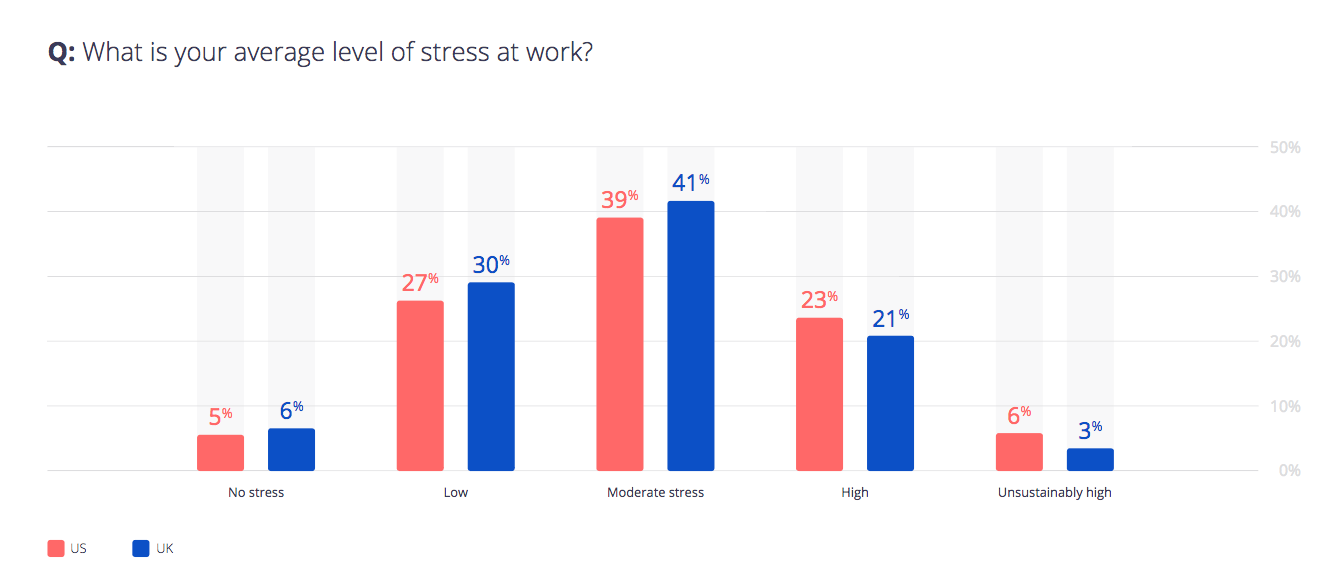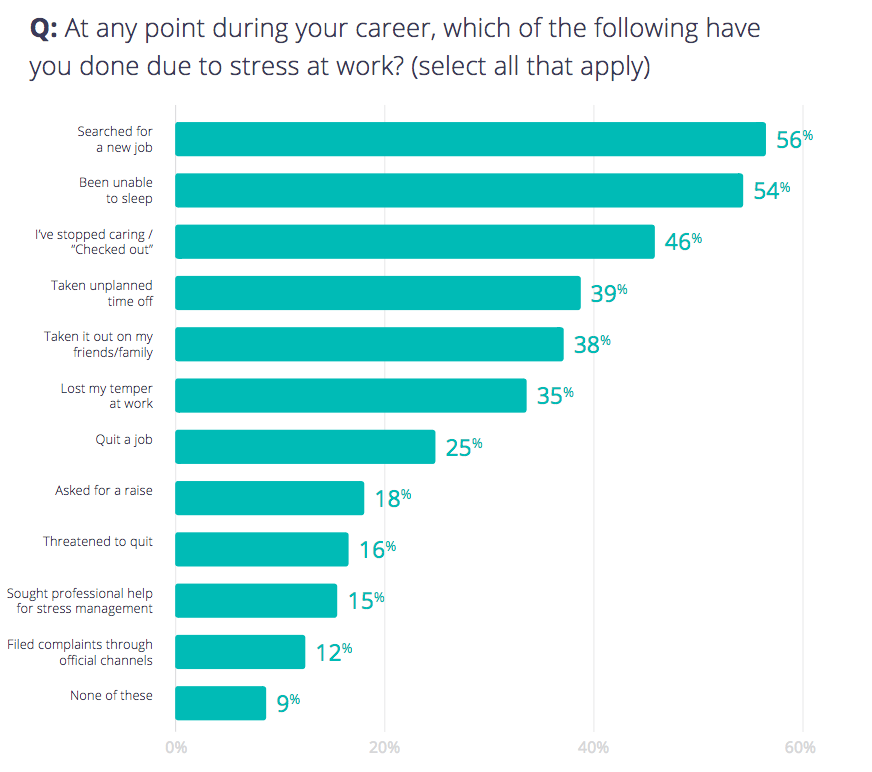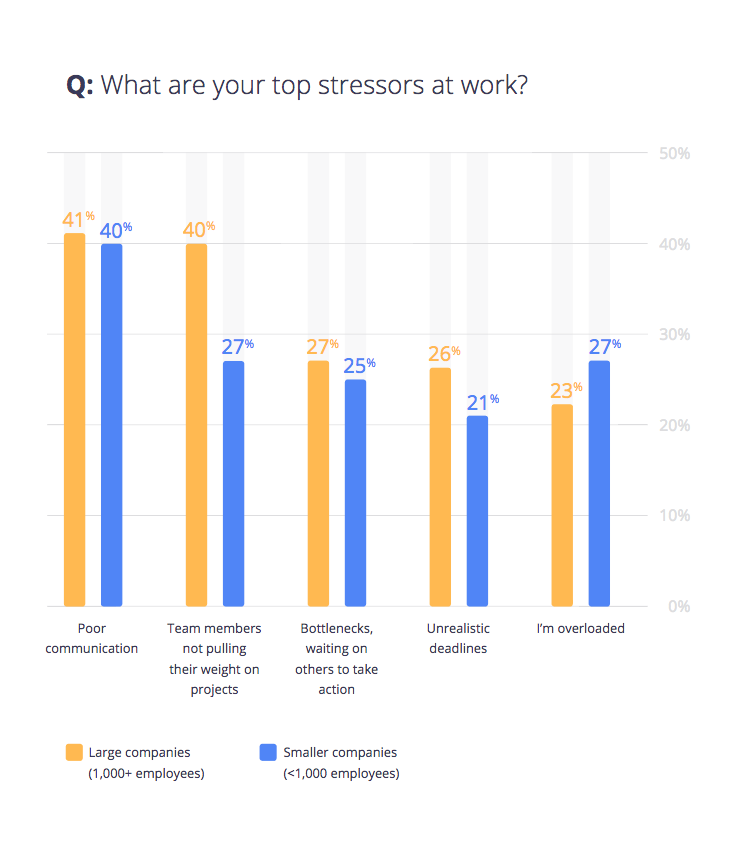Key takeaways:
- What percentage of workers experience stress at work? 94% of workers report feeling stress at work, with one-third facing high to unsustainable levels.
- How does workplace stress impact employees? Over 54% say stress negatively affects their home life weekly, and 50% experience sleep loss due to stress.
- What happens to productivity due to chronic stress? Chronic stress can decrease work quality and employee engagement, costing companies $450-$550 billion in lost productivity annually.
- What are the top causes of employee stress? Poor communication, team members not contributing, and bottlenecks in collaboration are major stressors.
- What can companies do to reduce stress? Implementing work management solutions can enhance collaboration, improve visibility, and help manage workloads effectively.
Stuck in traffic, giving a presentation, hosting the in-laws: Events that cripple confidence and spike stress.
Stress isn’t a foreign feeling—especially at work. We’ve all experienced workplace stress or anxiety before. In some cases it might’ve even driven us to perform our best. However, frequent and consistent stress results in a rapid decline in productivity, and even worse, overall health. The pressure of working from home is now also creating additional stress and remote work burnout.
Wrike asked more than 1,600 US and UK employees about the primary causes and effects of stress in the workplace. Our results show that with their health and home life at risk, workers are refusing to tolerate stress and looking for a way out.
Companies that refuse to prioritize reducing employee stress will pay the price. Let’s break down some of our key findings.
Chronic stress is prevalent in the workplace
Some 94% of workers report feeling stress at work, and almost a third say their stress level is high to unsustainably high. Elevated stress levels not only impact work productivity, but also affect employees’ personal lives.

About 54% of survey respondents report stress from work negatively affects their home life at least once a week—some say everyday. Over 50% also experience sleep loss due to stress.
Despite the common perception that people perform better in high-pressure work environments, over a quarter of respondents report a decline in work quality due to stress. In other words, overly stressed employees aren’t a sign companies are getting the most out of employees—they may actually be getting less.
“We’re under the misguided presumption that more work leads to more productivity when the opposite is actually true—chronic stress eats away at any chance for a productive workplace, or high employee engagement,” says Dr. Leah Weiss, author of How We Work: Live Your Purpose, Reclaim Your Sanity, and Embrace the Daily Grind and professor at Stanford University. “Chronic stress undermines culture and leads to fatigue, anxiety, and confusion about priorities.”

Workers only last so long under constant stress. Our survey reports over a quarter of employees say that they will burn out in the next 12 months if their stress levels don’t change—and burnout is expensive.
Almost 50% of workers say workplace stress has caused them to “check out” or stop caring at some point in their career. Checked out employees cost companies $450 to $550 billion in lost productivity every year, according to Gallup.

Over half of respondents looked for a new job and 25% report they’ve quit a job due to stress. In fact, 46% of HR leaders say employee burnout is responsible for up to 50% of their annual workforce turnover, as reported in a study by Kronos Incorporated and Future Workplace.
Say 11% of employees at a company of 1,000 are experiencing the negative impacts of stress at home every day. Of these 110 employees, 50 decide to quit due to stress (45% of this group). From lost productivity to onboarding and hiring costs, a company typically spends about 75% of an employee’s annual salary to replace them.
If these 50 employees were making $60,000 a year before they quit, hiring replacements will cost $2.25 million.
What’s burnout costing your company? Download our full report to find out.
Poor collaboration is the culprit
Companies must understand the root cause of employee stress and burnout before they can address it. The top three stressors are related to breakdowns in teamwork and collaboration, according to our survey:
- Poor communication
- Team members not pulling their weight
- Bottlenecks and waiting on others

Despite being saturated with communication channels, inefficient collaboration is now the key driver of stress in the workplace. In fact, 29% of respondents report using seven to more than 16 applications to complete their work in a single day.
About 36% of managers spend anywhere from six to 15 hours a week in meetings, and 62% spend two to four hours every day in email, according to our survey. With 98% of managers spending 40% to 87% of their work week on communication alone, how can they find time to improve their teams’ stress levels?
To combat the stress epidemic, companies must change the way teams collaborate and how work is managed. A work management solution eliminates information silos and makes key work details easy to locate across an organization. This helps reduce the stress caused by missing information needed to get work done for both managers and workers.
This technology also gives management a better picture of each team member’s workload and capacity. With this level of improved visibility, managers can distribute work appropriately and easily see project statuses without interrupting team members for updates.
Head towards transformation or employees will head for the door
Stifling productivity and losing top talent are risks no company can afford. With the job market thriving, employees are looking for jobs that enhance their quality of life—not hinder their performance.
If employers continue to turn their heads the other way when faced with reducing workplace stress, employee turnover will skyrocket—costing companies millions.
Download our full report to learn more about the cost of stress-induced turnover and find out how to start transforming your team into a productive powerhouse.




